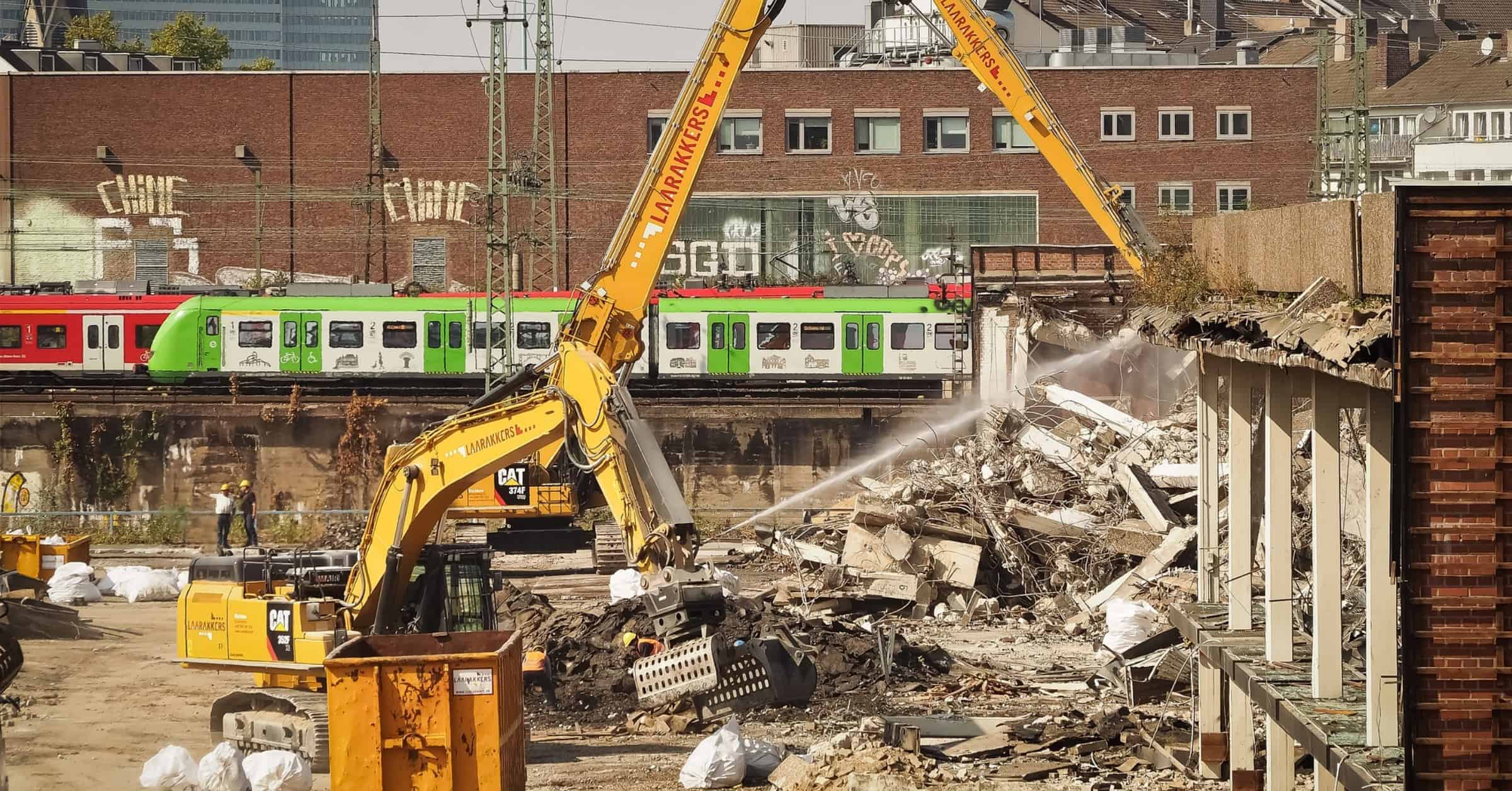The need for building demolition can arise for various reasons; whether a building has reached the end of its serviceable life or there is simply no longer a need for the building. Not all buildings are created equally and the way in which you go about demolition can vary wildly; from careful and meticulous deconstruction by excavators to the rather more spectacular controlled explosive demolition by professional building demolition contractors. Practically, how do you go about turning a building into a pile of rubble? Let us explain!
What is the difference between building alteration and demolition?
Sometimes, full building demolition is not needed. There are numerous options that come under the umbrella term “building alterations”, broadly speaking this is work intended to change the function or appearance of a building. These include but are not limited to: partial demolitions, extensions, linking or separating spaces and maintenance. These partial demolitions can be carried out as demolition construction, where sections of the building are torn down to be renovated. However, in other circumstances, there is a need or desire to remove a building completely.
What do demolition companies actually do when they set about removing a building?
Generally speaking, building demolitions will fall into one of two categories:
- Dismantling/deconstruction – this involves the careful dismantling of a structure with the intention of preserving parts for reuse, refurbishment or recycling. This can be highly labor intensive and requires patience and care from the demolition crew.
- Explosive demolition – this is a highly specialized form of building demolition, carried out by expert building demolition contractors, including using controlled explosions that target the structural support of a building, causing it to collapse in on itself. Sometimes also referred to as an implosion, the intention is for the debris to fall within the area that the building was previously occupying.
When they collapse a building, there is a countdown and sirens to let everyone know that a building is coming down. But when do the sirens go off and how much time is left before the charges go off? The blast controllers will sound a siren at the 10-minute, five-minute and one-minute mark. This is to make sure everyone is clear of the blast zone.
Why would you need to demolish a building?
One of the most common reasons is because a building is old. Older buildings require a lot of maintenance, the requirement for costly and lengthy repairs can render the building useless as it is no longer cost effective to run it. Older buildings tend to have a weak infrastructure, which means that the demolition process will be cheaper than the price to maintain or renovate it.
Other scenarios that lead to the need for demolition include: faulty/unstable foundations, dangerous pest or material infestations or if the owner is looking to sell the vacant lot.
What happens pre-demolition?
When a building is slated for demolition, it is vacated and secured while arrangements for demolition are made. These arrangements are essential to ensuring the building demolition process is able to be carried out safely, efficiently and within regulation.
Firstly, you need to liaise with the authority/business owner of the site to discuss any pre-demolition requirements. Things like safety measures that must be put in place, damage or collapse of the foundations or if they have any area of the building that requires protection or extra care as the work commences.
Next, the building must be surveyed. This will give you a professional understanding of the structural condition of the building, highlighting any potential difficulties or risks such as asbestos.
Then you must ensure the entire building demolition team is in adherence to the demolition regulations in the local area and the demolition has approval from the local authorities. For most demolition jobs you will need to obtain a permit. Jobs in which you will need a permit are:
- A primary structure, or structures, will be removed from a lot.
- Any accessory structures with utility systems, mechanical systems, hazardous materials or a basement-type foundation will be removed from a lot.
- A building that is having a renovation that requires a substantial amount of demolition.
How to get a building demolition permit?
In order to obtain a building demolition permit, you must first complete a permit application. In many cases, you will also need to submit a grading (changing the surface of the ground) plan and have this approved. Furthermore, you will need a successfully completed and inspected plumbing permit.
Finally, depending on the state regulations, a cash demolition escrow bond may be required to ensure the safe, sanitary, and secure completion of the demolition work. This bond is typically refundable upon completion of the demolition.
There are cases in which you do not need a demolition permit, such as:
- Removing small sheds, small garages, or any other minor accessory structures that do not contain utilities with separate connections or a basement-type foundation.
- Removing decks, porches, and other similar appendages to structures where the intent is to rebuild after removal.
- Performing interior demolitions with the intent of renovating after the demolition.
To summarize, a permit is necessary to completely remove a structure down to the foundation in most states and you need a separate permit for each structure being demolished.
How to tear down a house and what it’ll cost!
So how do I go about tearing down a house? House Demolition costs can range from anywhere between $2 and $17 per square foot depending on the area, contractor and a whole host of other variables. The average cost to demolish a house is somewhere between $4 and $15 per square foot.
This means for many regularly sized houses, prices for a full demolition job can range from between $5,000 and $30,000. There are also site preparation costs incurred in hiring electricians and plumbers, this ensures that the electricity, gas and water are all turned off before any demolition work can begin.
These specialists usually cost between $50 and $100 per hour. It is the responsibility of the owner and project manager to coordinate with the building engineer when demolition takes place to ensure all plumbing locations are secured and not in danger of being damaged. The cost to tear down a house can initially seem steep; however, it can actually increase the value of the lot in some cases.
Selling a vacant lot comes with a big premium as opposed to a useless, derelict building. If you are in need of a garage demolition, garage demolition costs an average of between $2,000 and $9,000. Furthermore, prices for shed demolition and removal are usually charged hourly, at a rate of between $50 and $100.
What is the cost of demolition for commercial buildings?
For commercial building demolition, the average cost is between $4 and $8 per square foot. Usually, the price per square foot decreases with total square footage. However, in busy urban areas like Washington DC, you’re more likely to pay between $5 and $10 per square foot. The codes and
standards referenced in 2013 Kentucky building code are considered part of the requirements of commercial demolition jobs. What are these demolition guidelines addressed in the 2013 Kentucky building code? The code establishes minimum/maximum requirements to safeguard public health, safety and general welfare and the code includes the need for sanitary facilities to be provided at construction and demolition sites.
How can I keep dust out during building demolition?
During renovation and demolition, it is inevitable that dust is going to find its way into every nook and cranny of your house, creating a thick film over your rooms and furniture. There are ways you can mitigate the damage done by dust.
Firstly, you must prepare the workspace by removing personal items and items you don’t want to get dirty. For items of furniture that you can’t move, like sofas, make sure you cover them with a thick, dust-proof sheet.
Next, set up dust barriers! Using masking tape, lay plastic sheets on the floor, hang plastic sheets on the walls and baseboards and use a zip wall across the entrance. Furthermore, you can use an air scrubber to capture dust while it is airborne. Air scrubbers then filter the dusty air and blow it outside.
You can rent an air scrubber for $150 – $200 per week and they can really help with the clean-up process. Using an industrial vacuum at the end of each day can also help stop the buildup of thick dust before you do a deep clean once the work is completed.
What is done with the debris and how much is recycled?
Demolition debris can be disposed of in either Construction and Demolition Debris landfills or (depending on the state), solid waste landfills. Alternatively, debris may also be sorted and recycled.
Recycling is the environmentally preferred method and great efforts are being made to increase the percentage of waste that is recycled. Recent projects, like the redevelopment of Brillion Iron Works’ foundry, have yielded astonishing results: “For this project, over 90% of the building materials were recycled/repurposed, with over 80% of the demolition material recycled/repurposed onsite. Of the less than 20% of material transported offsite, over 60% is being recycled/repurposed for after-market use. This resulted in very little material ending up in a landfill”
So how do I get started?
Building demolition can seem like a scary and daunting undertaking, with lots of regulations that must be adhered to and lots of precautions that must be taken. However, there is lots of information and advice available from professionals in the field who are happy and waiting to support you, whatever your needs.
Demolition can change the value, function and purpose of a plot of land and with the right preparation and support, there should be nothing that stands in the way of you transforming your land! Ready to go ahead with demolition work? Contact a contractor in your local area; get a quote, speak to an expert and you’ll be guided right through the project of your dreams!









